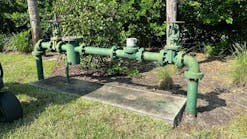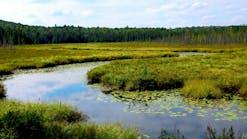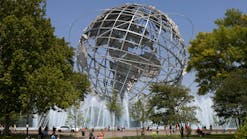In Part 2 of this continuing series, author Margaret Buranen continues to showcase how the Indianapolis Nature Conservancy’s headquarters proactively uses rainwater harvesting through site-based applications and approaches to rainwater filtration.
This organization demonstrates a comprehensive stormwater system designed from the headquarters’ parking lot to its rooftop. This segment reflects the organization’s many effective efforts to control and utilize rainwater harvesting onsite thereby negating runoff through combined sewer overflows (or any such reliance upon site-based sewers).
Our writer for Stormwater journal—the original print-based source for this full-length article—continues to describe the stormwater management planning and project implementation with a focus upon stormwater runoff (and pollutant discharge) elimination best practices.
Taking Runoff Off the Table (Part 2) By Margaret Buranen
Under a consent decree for CSOs, Indianapolis looks for creative solutions. A LEED Platinum Conservation Center (continued) One-third of the (Indianapolis Nature Conservancy’s) parking lot has permeable pavers. A bioswale that runs along the parking lot’s length collects runoff from its impervious section. The bioswale contains blueflag iris, tussock sedge, meadowsweet, winterberry, twigged dogwood, and other native plants. “It’s unbelievable how quickly the water drains,” says McConnell. “Within 15 minutes of the rain stopping, there is no water left in the swale.” Ten varieties of sedum grow on The Nature Conservancy’s 7,500-square-foot extensive green roof. The building also has a 500-square-foot intensive green roof with 24 inches of growing medium. Both roofs drain to a 2,500-gallon cistern in the basement. When the cistern or bioswale reaches capacity, runoff goes into an infiltration gallery beneath the bioswale. Outside, facing the basement’s windows, is a living wall 16 feet high. It absorbs some rainfall, but its primary purpose is to allow daylight into the basement, saving on lighting. The wall features native plants such as wild geranium, wintergreen, columbine, and maidenhair fern. This retaining wall, built of concrete blocks with plants growing within its spaces, is reminiscent of plants growing in the spaces on the sides of cliffs in southern Indiana. All of the rain that falls on The Nature Conservancy site stays on the site, either captured for use or infiltrated. It eventually filters through to Pogue’s Run, which runs underneath the city to the White River. “Every drop of water that falls onsite is utilized in some part of the project,” explains Osburn. “There weren’t any sewers on site. We would have had to extend a sewer line a block or half a block, and that would have added a lot to the cost.” That lack of sewer outlets “steered us to a zero-runoff solution.” This was a real challenge, he adds, “but also caused us to think how we could use stormwater creatively, how we could minimize runoff and use it for irrigation and for a graywater system in the building.” Rainwater collected in the center’s underground cistern is used to water the native plantings or to flush the building’s toilets. That reduces The Nature Conservancy’s water bill. Because of its rain capture system, The Nature Conservancy site is not connected to the city’s CSS. The environmental organization doesn’t add to the problem of CSOs. McConnell says that the city will save almost $700,000 over a 30-year period by not having to deal with runoff from the site. Osburn says that the building was “designed as a showcase not only for The Nature Conservancy’s work, but as an educational tool for school, corporate, and nonprofit groups who are interested in how you achieve a sustainable building on an urban, highly compact site.” McConnell says that the building attracts many visitors. “Most people are just awed by what we’ve done with our stormwater. We have geothermal, wind turbines, and other features, but stormwater is what we get the most interest in, and it’s what I am most proud of.” The Wabash River, the largest undammed river east of the Mississippi River, drains two-thirds of Indiana. One of the Wabash’s tributaries is the White River, which flows through Indianapolis. McConnell says that fresh water conservation is very important to The Nature Conservancy. “By protecting groundwater and not adding to the city’s CSOs, we’re protecting Indiana’s river. We’re walking the talk.” Please see the soon-to-be-released Part 3 installment for the continuation of this topic. To read the previous post (or series of posts) in this series, click on the following link(s) below. Part 1Taking Runoff Off the Table (Part 2) By Margaret Buranen
Under a consent decree for CSOs, Indianapolis looks for creative solutions.
A LEED Platinum Conservation Center (continued)
One-third of the (Indianapolis Nature Conservancy’s) parking lot has permeable pavers. A bioswale that runs along the parking lot’s length collects runoff from its impervious section. The bioswale contains blueflag iris, tussock sedge, meadowsweet, winterberry, twigged dogwood, and other native plants.
“It’s unbelievable how quickly the water drains,” says McConnell. “Within 15 minutes of the rain stopping, there is no water left in the swale.”
Ten varieties of sedum grow on The Nature Conservancy’s 7,500-square-foot extensive green roof. The building also has a 500-square-foot intensive green roof with 24 inches of growing medium. Both roofs drain to a 2,500-gallon cistern in the basement.
When the cistern or bioswale reaches capacity, runoff goes into an infiltration gallery beneath the bioswale. Outside, facing the basement’s windows, is a living wall 16 feet high. It absorbs some rainfall, but its primary purpose is to allow daylight into the basement, saving on lighting.
The wall features native plants such as wild geranium, wintergreen, columbine, and maidenhair fern. This retaining wall, built of concrete blocks with plants growing within its spaces, is reminiscent of plants growing in the spaces on the sides of cliffs in southern Indiana.
All of the rain that falls on The Nature Conservancy site stays on the site, either captured for use or infiltrated. It eventually filters through to Pogue’s Run, which runs underneath the city to the White River.
“Every drop of water that falls onsite is utilized in some part of the project,” explains Osburn. “There weren’t any sewers on site. We would have had to extend a sewer line a block or half a block, and that would have added a lot to the cost.” That lack of sewer outlets “steered us to a zero-runoff solution.”
This was a real challenge, he adds, “but also caused us to think how we could use stormwater creatively, how we could minimize runoff and use it for irrigation and for a graywater system in the building.”
Rainwater collected in the center’s underground cistern is used to water the native plantings or to flush the building’s toilets. That reduces The Nature Conservancy’s water bill.
Because of its rain capture system, The Nature Conservancy site is not connected to the city’s CSS. The environmental organization doesn’t add to the problem of CSOs. McConnell says that the city will save almost $700,000 over a 30-year period by not having to deal with runoff from the site.
Osburn says that the building was “designed as a showcase not only for The Nature Conservancy’s work, but as an educational tool for school, corporate, and nonprofit groups who are interested in how you achieve a sustainable building on an urban, highly compact site.”
McConnell says that the building attracts many visitors. “Most people are just awed by what we’ve done with our stormwater. We have geothermal, wind turbines, and other features, but stormwater is what we get the most interest in, and it’s what I am most proud of.”
The Wabash River, the largest undammed river east of the Mississippi River, drains two-thirds of Indiana. One of the Wabash’s tributaries is the White River, which flows through Indianapolis. McConnell says that fresh water conservation is very important to The Nature Conservancy. “By protecting groundwater and not adding to the city’s CSOs, we’re protecting Indiana’s river. We’re walking the talk.”
Please see the soon-to-be-released Part 3 installment for the continuation of this topic. To read the previous post (or series of posts) in this series, click on the following link(s) below.






